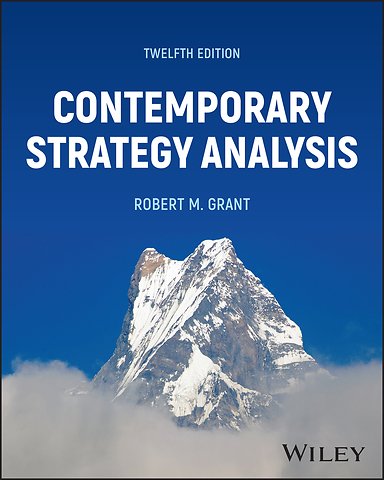Contemporary Strategy Analysis
Paperback Engels 2024 12e druk 9781394251599Samenvatting
The updated new edition of the classic strategic analysis textbook, addresses the emerging challenges that businesses face in an increasingly complex and dynamic environment
A market-leading title across the world in upper-level undergraduate and MBA courses, Contemporary Strategy Analysis combines a rigorous approach to business strategy analysis with highly relevant examples of current practice and a rich collection of case studies. With a lively narrative style, expert strategist and lecturer Robert M. Grant introduces students to some of the latest thinking in the strategy field while addressing the strategic issues that business enterprises face today.
Designed to be accessible for students from different backgrounds with varying levels of experience, the twelfth edition of Contemporary Strategy Analysis builds upon its tradition of clarity of exposition, emphasis on practicality, and concentration on the fundamentals of value creation and appropriation. A wide range of contemporary topics are presented alongside fully integrated business models, real-world examples of business model innovation, and practical tools for formulating and implementing business strategies.
Contemporary Strategy Analysis, Twelfth Edition, remains the ideal textbook for core strategy courses in Business Studies, Management, and MBA programs, as well as for executive courses on competitive strategy, corporate strategy, and management consulting skills. It is also a valuable resource for managers, business owners, founders, and other professionals who are responsible for the strategic direction of a modern enterprise.
New to this Edition and Additional Features
• Consideration of the implications of profound uncertainty for strategy formulation and the role of theorizing as a basis for initiating breakthrough strategies
• Emphasis on the role of business ecosystems—especially in supporting innovative business models
• Further consideration of network externalities and the potential for platforms to exploit network effects in digital markets
• Attention to the impact of environmental, social, and governance (ESG) issues in strategy and the challenges to business of an increasingly polarized political landscape
• Exploration of the implications of artificial intelligence (AI) for strategic decision making and the future role of managers
• New case studies of SpaceX, Nvidia, and Amazon and updated cases on Netflix v. Disney, Manchester City FC, Zara, Starbucks, and others
Specificaties
Lezersrecensies
Inhoudsopgave
1. The Concept of Strategy
PART II THE TOOLS OF STRATEGY ANALYSIS
2. Goals, Values, and Performance
3. Industry Analysis: The Fundamentals
4. Further Topics in Industry and Competitive Analysis
5. Analyzing Resources and Capabilities
6. Organization Structure and Management Systems: The Fundamentals of Strategy Implementation
PART III BUSINESS STRATEGY AND THE QUEST FOR COMPETITIVE ADVANTAGE
7. The Sources and Dimensions of Competitive Advantage
8. Industry Evolution and Strategic Change
9. Technology‐Based Industries and the Management of Innovation
PART IV CORPORATE STRATEGY
10. Vertical Integration and the Scope of the Firm
11. Global Strategy and the Multinational Corporation
12. Diversification Strategy
13. Implementing Corporate Strategy: Managing the Multibusiness Firm
14. Current Trends in Strategic Management
CASES
Anderen die dit boek kochten, kochten ook
Rubrieken
- advisering
- algemeen management
- coaching en trainen
- communicatie en media
- economie
- financieel management
- inkoop en logistiek
- internet en social media
- it-management / ict
- juridisch
- leiderschap
- marketing
- mens en maatschappij
- non-profit
- ondernemen
- organisatiekunde
- personal finance
- personeelsmanagement
- persoonlijke effectiviteit
- projectmanagement
- psychologie
- reclame en verkoop
- strategisch management
- verandermanagement
- werk en loopbaan






